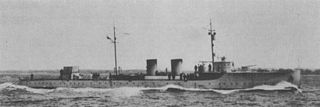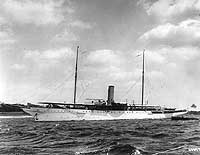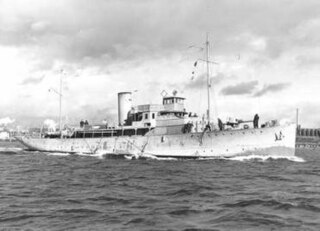
USS Winchester (SP-156) was an armed yacht that served in the United States Navy as a patrol vessel from 1917 to 1919. Prior to and following World War I, Winchester was a private yacht, later renamed Renard. In World War II, Renard was requisitioned for use in the Royal Canadian Navy as a patrol vessel, keeping her name. She was returned to her owners in 1944.

HMCS Beaver was an armed yacht that served in the Royal Canadian Navy during the Second World War. Originally named Aztec, the yacht was requisitioned for service in the United States Navy during the First World War under the same name. Returned to her owner in 1919, the yacht was laid up in 1931 following her owner's death. The vessel was purchased via a third party for service in the Royal Canadian Navy and after commissioning, Beaver was primarily used as a training ship with limited time as a patrol vessel. Following the war she was sold in 1946 and broken up for scrap in 1956.
HMCS Caribou was an armed yacht that served in the Royal Canadian Navy during the Second World War. Originally named Memory III, the vessel was renamed Elfreda while in private use as a personal yacht. After her commissioning and renaming to Caribou, she was used as a patrol and training vessel on the East coast of Canada. Following the war the ship was sold for commercial use until her registry was deleted in 1963.

HMCS Elk was an armed yacht serving with the Royal Canadian Navy during the Second World War. Prior to Canadian service, the ship was named Arcadia. She was used initially as a patrol vessel, but later saw use as a training and guard ship for submarines on the East Coast of Canada. Following the war, Elk was sold for commercial use and returned to her original name. She was renamed Grand Manan III in 1946 and used as a short-haul passenger ferry before being broken up in 1968.

HMCS Raccoon was an armed yacht that served in the Royal Canadian Navy during World War II. Purchased by the Royal Canadian Navy in 1940, the ship was originally known as the yacht Halonia. Used as a patrol vessel and convoy escort, the ship was sunk by the German submarine U-165 in the St. Lawrence River on 7 September 1942. Raccoon was escorting Convoy QS-33 at the time. The entire ship's crew was lost.
HMCS Clayoquot was a Bangor-class minesweeper that served with the Royal Canadian Navy during the Second World War. She saw action mainly in the Battle of the Atlantic. She was sunk in 1944. The minesweeper was named after Clayoquot Sound on Vancouver Island, British Columbia.
HMCS Lachine was a Bangor-class minesweeper of the Royal Canadian Navy that served during the Second World War. Following the war a proposed transfer to the Royal Canadian Mounted Police as Starnes was cancelled, and the ship was instead sold for conversion to a salvage tug in 1945. The ship was broken up in the United Kingdom in 1955.
HMCS Noranda was a Canadian Bangor-class minesweeper built for the Royal Canadian Navy in 1940. She was launched on 13 June 1941 and escorted convoys for the rest of the war. After the war the minesweeper was refitted and was transferred to the Royal Canadian Mounted Police as Irvine. In 1962, the ship was sold and was turned into the yacht Miriana. Renamed Marijana and Viking L&R in 1969, the yacht sank in May 1971 off the coast of Jamaica.
HMCS Gananoque was a Bangor-class minesweeper constructed for the Royal Canadian Navy during the Second World War. Named for the town of Gananoque, Ontario situated on the Saint Lawrence River, the minesweeper entered service in 1941 and participated in the Battle of the Atlantic and the Battle of the Saint Lawrence, mainly as a convoy escort. Following the end of the war in 1945 Gananoque was decommissioned and placed in reserve. The vessel was reacquired in 1952, but never reentered service and was sold for scrap in 1959 and broken up.
HMCS Grandmère was a Bangor-class minesweeper constructed for the Royal Canadian Navy during the Second World War. Entering service in 1941, the minesweeper took part in the Battle of the Atlantic and the Battle of the St. Lawrence before being taken out of service in 1945. The ship was sold for mercantile service following the war, first as the yacht Elda and then the cargo ship Jacks Bay. The ship was sold for scrap in 1968.
HMCS Mahone was a Bangor-class minesweeper constructed for the Royal Canadian Navy during the Second World War. Entering service in 1941, the ship took part in the Battle of the Atlantic and the Battle of the Saint Lawrence as a convoy escort. Following the war, the minesweeper was decommissioned and placed in reserve. Reacquired during the Korean War, Mahone was never recommissioned into the Royal Canadian Navy and was instead sold to the Turkish Navy in 1958. Renamed Beylerbeyi, the minesweeper remained in service until 1972 when she was discarded.
HMCS Medicine Hat was a Bangor-class minesweeper that served with the Royal Canadian Navy during the Second World War. Entering service in 1941, the minesweeper was primarily used as a convoy escort in the Battle of the Atlantic and the Battle of the St. Lawrence. Following the war the vessel was laid up until reacquired during the Korean War. Never re-entering service with the Royal Canadian Navy, Medicine Hat was sold to the Turkish Navy in 1957. Renamed Biga, the minesweeper was discarded in 1963.
HMCS Swift Current was a Bangor-class minesweeper that served with the Royal Canadian Navy during the Second World War. Entering service in 1941, the warship used as a training ship and convoy escort and took part in the battles of the St. Lawrence and the Atlantic. Following the war the ship was laid up until reacquired during the Korean War. Never re-entering service with Canada, Swift Current was sold to the Turkish Navy in 1958. Renamed Bozcaada, the minesweeper was discarded in 1971.
HMCS Milltown was a Bangor-class minesweeper that served with the Royal Canadian Navy during the Second World War. The vessel entered service in 1942 and took part in the Battle of the Atlantic, Battle of the St. Lawrence and the invasion of Normandy. Milltown was laid up following the war, but reacquired in 1952 during the Korean War. The ship never re-entered service with the Royal Canadian Navy and was sold for scrap in 1959.
HMCS Truro was a Bangor-class minesweeper that served with the Royal Canadian Navy during the Second World War. The minesweeper entered service in 1942 and took part in the Battle of the Atlantic and the Battle of the St. Lawrence. Following the war, the vessel was transferred to the Royal Canadian Mounted Police and renamed Herchmer. In 1946, Herchmer was sold for mercantile conversion and reappeared as Gulf Mariner. The ship was abandoned in 1964 on the Fraser River shore after plans for conversion to a suction dredger failed. The abandoned hulk was broken up.

HMCS Preserver was a depot ship of the Coastal Forces of the Royal Canadian Navy during World War II. Commissioned in July 1942, Preserver supported Canadian Fairmile B motor launches in Canadian and Newfoundland waters during the war.
HMCS Lynx was an armed yacht in service with the Royal Canadian Navy (RCN) during World War II. The vessel was built at Newport News Shipbuilding as the yacht Dolphin in 1922. The yacht was sold in 1929, becoming Ramona. In 1940, the RCN acquired the vessel as part of the effort to bolster its patrol forces, armed and renamed the vessel Lynx. However, the vessel suffered a series of mechanical issues and was taken out of service in 1943 and sold for commercial service. Renamed Elena and then Samana Queen the ship was used in the banana boat trade, taking on its final name Rican Star in 1952. The vessel was converted to a fishing trawler in 1959 before sinking on 25 May 1960 off Hummocky Island, Queensland.
HMCS Husky was an armed yacht used for patrol and training purposes during World War II by the Royal Canadian Navy. The ship was constructed as the yacht Wild Duck in 1930 in Bay City, Michigan. Having several owners through the 1930s, the vessel was renamed Xania II. Acquired by the Royal Canadian Navy in 1940 for patrol, escort and training duties in Atlantic Canada, the ship was taken out of service at the end of the war and sold into commercial service. The vessel was purchased by the Port of New Orleans, Louisiana for use as an inspection ship. In 1967 the ship was sold again, renamed Aquarius No. 2 and used as a diving tender based in Honduras. In 1979 the vessel was acquired by American interests who brought the ship back to New Orleans and converted it to a floating restaurant.
HMCS Vison was an armed yacht of the Royal Canadian Navy during World War II. The vessel was acquired in 1940 for use as a patrol boat and later, as a training ship. In 1946, following the end of the war, Vison was sold into private ownership. The vessel was constructed as Avalon in 1931 by Pusey & Jones of Wilmington, Delaware, United States on behalf of Ogden L. Mills, the Secretary of the United States Treasury. During its service during World War II, Vison participated in the Battle of the Atlantic and the Battle of the St. Lawrence escorting convoys and defending them against German U-boats.
HMCS Otter was an armed yacht in service with the Royal Canadian Navy during World War II. Launched in 1921, the vessel was constructed as Nourmahal for Vincent Astor of New York as a pleasure yacht. He sold the vessel in the late 1920s and it was renamed Conseco. The Royal Canadian Navy, finding a lack of suitable vessels in Canadian ownership to be taken into naval service, sent Canadian yacht owners south to the United States to find those vessels. Conseco was acquired and brought north to Halifax, Nova Scotia where the vessel was converted to an armed yacht in 1940. Renamed Otter the ship participated in the Battle of the Atlantic, escorting convoys and patrolling the Canadian coast. On 26 March 1941, Otter suffered a catastrophic fire aboard that sank the armed yacht. Two officers and seventeen ratings died in the incident.




